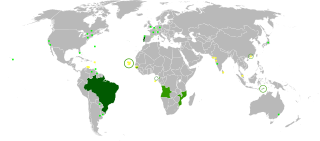Related Research Articles
Modern Hebrew is phonetically simpler than Biblical Hebrew and has fewer phonemes, but it is phonologically more complex. It has 25 to 27 consonants and 5 to 10 vowels, depending on the speaker and the analysis.
In phonetics, rhotic consonants, or "R-like" sounds, are liquid consonants that are traditionally represented orthographically by symbols derived from the Greek letter rho, including ⟨R⟩, ⟨r⟩ in the Latin script and ⟨Р⟩, ⟨p⟩ in the Cyrillic script. They are transcribed in the International Phonetic Alphabet by upper- or lower-case variants of Roman ⟨R⟩, ⟨r⟩:, ,, ,, ,, and.
Uvulars are consonants articulated with the back of the tongue against or near the uvula, that is, further back in the mouth than velar consonants. Uvulars may be stops, fricatives, nasals, trills, or approximants, though the IPA does not provide a separate symbol for the approximant, and the symbol for the voiced fricative is used instead. Uvular affricates can certainly be made but are rare: they occur in some southern High-German dialects, as well as in a few African and Native American languages. Uvular consonants are typically incompatible with advanced tongue root, and they often cause retraction of neighboring vowels.
The phonology of Standard German is the standard pronunciation or accent of the German language. It deals with current phonology and phonetics as well as with historical developments thereof as well as the geographical variants and the influence of German dialects.

The phonology of Portuguese varies among dialects, in extreme cases leading to some difficulties in intelligibility. Portuguese is a pluricentric language and has some of the most diverse sound variations in any language. This article on phonology focuses on the pronunciations that are generally regarded as standard. Since Portuguese is a pluricentric language—and differences between European Portuguese (EP), Brazilian Portuguese (BP), and Angolan Portuguese (AP) can be considerable—varieties are distinguished whenever necessary.
The first Slovak orthography was proposed by Anton Bernolák (1762–1813) in his Dissertatio philologico-critica de litteris Slavorum, used in the six-volume Slovak-Czech-Latin-German-Hungarian Dictionary (1825–1927) and used primarily by Slovak Catholics.
Esperanto is a constructed international auxiliary language designed to have easy phonology. The creator of Esperanto, L. L. Zamenhof, described Esperanto pronunciation by comparing the sounds of Esperanto with the sounds of several major European languages.
This article is about the phonology of Bernese German. It deals with current phonology and phonetics, including geographical variants. Like other High Alemannic varieties, it has a two-way contrast in plosives and fricatives that is not based on voicing, but on length. The absence of voice in plosives and fricatives is typical for all High German varieties, but many of them have no two-way contrast due to general lenition.
The Uralic Phonetic Alphabet (UPA) or Finno-Ugric transcription system is a phonetic transcription or notational system used predominantly for the transcription and reconstruction of Uralic languages. It was first published in 1901 by Eemil Nestor Setälä, a Finnish linguist.
The Persian language has between six and eight vowels and 26 consonants. It features contrastive stress and syllable-final consonant clusters.
Old English phonology is necessarily somewhat speculative since Old English is preserved only as a written language. Nevertheless, there is a very large corpus of the language, and the orthography apparently indicates phonological alternations quite faithfully, so it is not difficult to draw certain conclusions about the nature of Old English phonology.
Dutch phonology is similar to that of other West Germanic languages, especially Afrikaans and West Frisian.
This article is about the phonology and phonetics of the Estonian language.
This article discusses the phonological system of Standard Bulgarian. Most scholars agree that contemporary Bulgarian has 45 phonemes but different authors place the real number of Bulgarian phonemes between 42 and 47, depending on whether one includes or excludes phonemes which appear primarily only in borrowed foreign words.
French exhibits perhaps the most extensive phonetic changes of any of the Romance languages. Similar changes are seen in some of the northern Italian regional languages, such as Lombard or Ligurian. Most other Romance languages are significantly more conservative phonetically, with Spanish, Italian, and especially Sardinian showing the most conservatism, and Portuguese, Occitan, Catalan, and Romanian showing moderate conservatism.
This article aims to describe the phonology and phonetics of central Luxembourgish, which is regarded as the emerging standard.
The phonology of Old Saxon mirrors that of the other ancient Germanic languages, and also, to a lesser extent, that of modern West Germanic languages such as English, Dutch, Frisian, German, and Low German.
This article is about the phonology and phonetics of the West Frisian language.
This article is about the phonology and phonetics of the Upper Sorbian language.
Chemnitz dialect is a distinct German dialect of the city of Chemnitz and an urban variety of Vorerzgebirgisch, a variant of Upper Saxon German.
References
- 1 2 3 4 5 6 7 8 9 Kleine (2003), p. 262.
- ↑ Katz (1987), p. 30.
- 1 2 3 4 5 Kleine (2003), p. 263.
- 1 2 3 Jacobs (2005 :28)
- ↑ Katz (1987 :17)
- ↑ Katz (1987 :25)